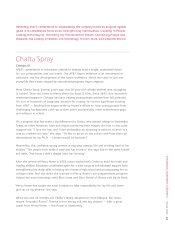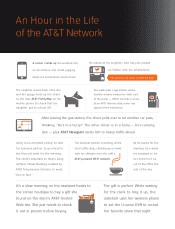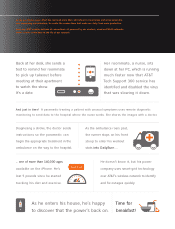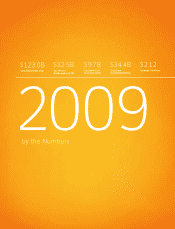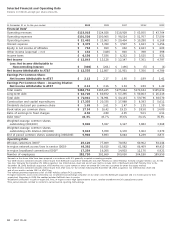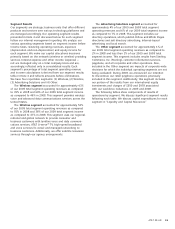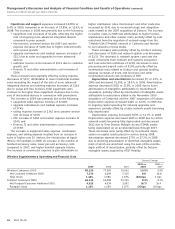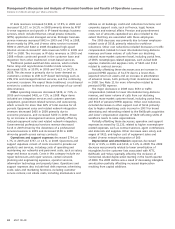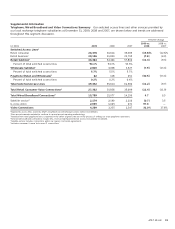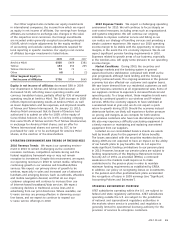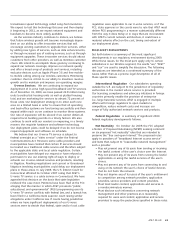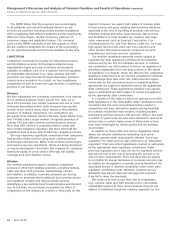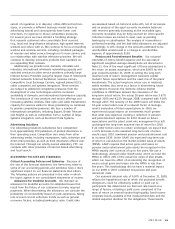AT&T Wireless 2009 Annual Report Download - page 37
Download and view the complete annual report
Please find page 37 of the 2009 AT&T Wireless annual report below. You can navigate through the pages in the report by either clicking on the pages listed below, or by using the keyword search tool below to find specific information within the annual report.
AT&T 09 AR 35
rate for postpaid customers was 1.16% for 2009 and 1.19%
for 2008, down from 1.27% for 2007. The decline in postpaid
churn reflects network enhancements and broader coverage,
more affordable rate plans and exclusive devices, and free
mobile-to-mobile calling among our wireless customers.
Wireless Operating Results
Our Wireless segment operating income margin was 24.8%
in 2009, 22.5% in 2008 and 16.4% in 2007. The higher margin
in 2009 was primarily due to revenue growth of $4,262, while
the higher margin in 2008 was primarily due to revenue
growth of $6,651. Each revenue increase exceeded the
corresponding operating expense increase of $2,075 in 2009
and $2,587 in 2008. The expense increase for 2008 is net of
a decrease in depreciation and amortization of $1,309.
Service revenues are comprised of local voice and data
services, roaming, long-distance and other revenue. Service
revenues increased $4,247, or 9.6%, in 2009 and $5,732, or
14.8%, in 2008. The increases consisted of the following:
• Dataservicerevenueincreasesof$3,539,or33.4%,in
2009 and $3,647, or 52.5%, in 2008. The increases were
primarily due to the increased number of subscribers and
heavier usage by subscribers of advanced handsets and
other data-centric emerging devices, such as netbooks,
eReaders, and mobile navigation devices. The increases
in data service ARPU of 22.0% in 2009 and 33.8% in
2008 reflect this trend. Our significant data growth also
reflects an increased number of subscribers using our
3Gnetwork.Dataservicerevenuesrepresentedapproxi-
mately 29.0% and 23.9% of our Wireless segment service
revenues in 2009 and 2008.
• Voiceandotherservicerevenueincreasesof$708,or
2.1%, in 2009 and $2,085, or 6.6%, in 2008. The increase
in 2009 was due to a 9.4% increase in the average number
ofwirelesscustomers,downfrom14.0%in2008.Voice
and other service ARPU declined 6.7% in 2009 and 6.5%
in 2008.
Equipment revenues increased $15, or 0.3%, in 2009 and
increased $919, or 22.9%, in 2008. The lower incremental
increase in 2009 was due to lower traditional handset sales,
offset by sales of more advanced integrated devices. The
increase in 2008 was due to higher handset revenues,
reflecting higher gross customer additions, and customer
upgrades to more advanced devices.
As the wireless industry continues to mature, we believe
that future wireless growth will become increasingly depen-
dent on our ability to offer innovative services, which will
encourage existing customers to upgrade their current
services and devices and will attract customers from other
providers, as well as on our ability to minimize customer
churn. Average service revenue per user (ARPU) in 2009 was
flat compared to 2008 after increasing 1% in 2008 compared
to 2007 primarily due to increased data services ARPU growth
offsetting declining voice and other service ARPU. ARPU
from postpaid customers increased 2.7% in 2009 and 3.7%
in 2008, reflecting usage of more advanced handsets, such
as Apple iPhone 3GS, by these customers, evidenced by a
23.5% increase in postpaid data services ARPU in 2009 and
a 36.4% increase in postpaid data services ARPU in 2008.
The continued increase in postpaid data services revenue was
related to increased use of text messaging, Internet access,
e-mail and other data services. We expect continued growth
from data services, as more customers purchase advanced
integrated devices and other emerging devices, such as
netbooks, eReaders, and mobile navigation devices, and
broadband laptop cards, and as we continue to expand our
network. The growth in data services ARPU in 2009 was offset
by a 6.7% decline in voice ARPU and the growth in data
services ARPU in 2008 was partially offset by a 6.5% decline
invoiceandotherserviceARPU.Voiceandotherservice
ARPU in 2009 and 2008 declined due to lower access
charges, roaming revenues, and long-distance usage. Increases
in our FamilyTalk® and reseller customer base, which have
lower ARPU than traditional postpaid customers, have also
contributed to these declines. For 2009, roaming revenues
were lower due to a decline in domestic roaming activity.
For 2008, roaming revenues were lower due to acquisitions
and rate negotiations as part of roaming cost savings
initiatives, which slowed international growth, and lower
regulatory cost recovery charges. We expect continued
pressure on voice and other service ARPU.
The effective management of customer churn is also
critical to our ability to maximize revenue growth and to
maintain and improve margins. Customer churn is calculated
by dividing the aggregate number of wireless customers who
cancel service during each month in a period by the total
number of wireless customers at the beginning of each month
in that period. Our customer churn rate was 1.48% for 2009,
down from 1.68% for 2008 and 1.67% for 2007. The churn


